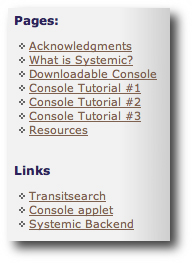
Image Source.
The Associated Press just published an article on how the Internet has facilitated an increasing number of collaborations between amateur and professional astronomers. The systemic project is one focus of the AP piece, and we’re seeing a jump in traffic as a result. If you are a first-time visitor to the site, welcome aboard!
There are several ways that you can use and participate in systemic. Our project home page is a weblog (updated fairly frequently) that gives an insider’s perspective on the latest developments and discoveries in the fast-moving fields of extrasolar planets and solar-system exploration. We write for a target audience of non-astronomers who are interested in astronomy. To get a flavor for the blog, keep reading the posts below, or have a look at a few of our past articles, such as our take on last Summer’s big “is Pluto a planet debate”, our exploration of what planets and galaxies really look like, or our series [1, 2, 3, 4] on the feasibility of detecting habitable terrestrial planets in the Alpha Centauri System.
You should see a set of links just to your right:

These links give you information that you can use to start participating in the actual discovery and characterization of extrasolar planets. (Despite the fact that we’re rocket scientists, we’ve been unable to consistently sweet-talk Microsoft IE into correctly displaying our site. On some versions of IE, you may have to scroll all the way down to the bottom of this page to see the links). The Downloadable Systemic Console is our Java-based software package that allows you to work with extrasolar planet data. The Systemic Backend is a collaborative environment that has the look and functionality of a social networking site. Registration and participation are free. The nearest well-characterized extrasolar planets (GJ 876 b, c and d) are 14.65 light years away, and so the news of useful modern innovations such as pop-ups and spyware hasn’t had time to propagate to those far-distant worlds. Hence the systemic backend is completely free of annoying ads!
One final note: there are two separate channels for registration on systemic. The first, accessed through the “login” tab on the site header above, is part of the WordPress package that runs the blog. Registration on the blog allows you to comment on our frontend posts. The second, accessed through the “backend” tab on the site header or the link to the right, gives you access to the collaborative php-based environment that constitutes the systemic backend. You can register for either or both, and you don’t need to give your real name or any real-world identifying information other than an e-mail address.
Tune in regularly for more news and updates.

Pingback: systemic - stability
Greg:
Magnificent website! I’m not quite sure of the concept but I like it anyway.
If you think this little comment is appropriate for the blog, please publish. Otherwise, no harm if I missed the mark. The piece is more science fiction than anything but it’s fun to look into the future sometimes.
Rob
One Possible Result of the Systemic Planet Search
Stand for a moment at the beginning of the last century. Airplanes, computers and DNA had yet to be invented or discovered. Men on the moon! Space travel out of the solar system! Could our grandfathers have even imagined the world at the end of “their†century?
What will we find at the end of “our†century? Perhaps those predictions that seem too bold at the moment are really the most likely to be realized. It is true that the greatest discoveries and inventions are likely those that we can not now envision, but we must, nevertheless, make the effort. This project may plant the seeds that will result in an incredible journey to the stars.
Migration from Earth
The engineering challenges that must be overcome for man to successfully migrate from one solar system to another are immense. Currently, we have barely begun to inventory the planets that surround our neighboring stars. In the next few decades, we will likely succeed in identifying earth-like planets. Hopefully, one of these sister worlds will be habitable. From time to time, it might be interesting to speculate about the day when mankind actually begins to journey toward one of the planets discovered in this planet search. For man to bridge the immense distances between our solar system and “New Earthâ€, we are going to have to come up with some dramatic improvements in our “conquest†of space. One possible method is suggested below.
A River of Light
Most of the energy created by our sun exits the solar system. Only a tiny fraction finds its way to Earth and only a very small percentage of that light is utilized by humanity. In the future, use of the free energy provided by the sun will increase. Perhaps our skill at capturing this energy will increase to such an extent that we can channel the rays of the sun into a river of light. Imagine that we can control and direct a fraction of the energy that eminates from the sun. Our concerns about fossil fuels will vanish in a second. Using this energy source from the sun, we may be able to build a bridge to the stars.
The engineering challenges will be immense. Certainly we will need to “conquer†space. Likely our use of robots will increase to such an extent that we will produce armies of robots to build on a grand scale. To redirect and concentrate the rays of the sun we will need to build immense “reflectors†in space. Like the teenage sun worshipper who redirects sunlight to her face by the placement of mirrors around her beach blanket, one day humanity may be able to direct sunlight by the strategic placement of giant “reflectors†in space. By concentrating sunlight into a river of energy, future engineers may be able to provide the light, heat, food and propulsion source to enable humankind to journey to the stars.
The energy source is just the beginning of the engineering challenges that must be overcome for man to migrate from one star to the next. Humans must live while star-sailing in and around this river of light. Perhaps future space ship builders will overcome the challenges of building a space station a thousand times bigger than our current effort. One need only compare the Wright brothers’ first effort to a 747 to see the potential. Possibly, we will develop the engineering infrastructure that will enable us to move small planets. Placing Enceadus, Europa and a few hundred other small planets at “Last Chance Cityâ€, the first outpost on the Star River, may provide the gravity, raw materials and protection from radiation that humans will need to survive in space for a hundred year migration to another star.
Societal Stability
The engineering challenges for a long migration of planetary pioneers will be formidable, but the sociological and political hurdles will be equally as difficult. Not least is guaranteeing societal stability for a long enough period of time so that residents of the solar system can maintain the machinery that created the star river. Stability within the star river will also be necessary. Like the pioneers who journeyed in covered wagons or the Pilgrims who faced a terrible ocean and an unknown land, the star migrants will need discipline and order in their community. Perhaps a “space patrol†will develop to maintain order. Possibly the military will control all use of the river, planets and/or space stations.
Where will the pioneers come from? Hopefully, Earth society will be peaceful and productive, at least to the extent that it can support a journey to the stars. It may be that a 100-year journey is not such a monumental undertaking if people live to the age of five centuries. Assuming we still live about one hundred years, though, volunteers will always come forward. Whether for religious, scientific, economic or governmental objectives, mankind has always had a pioneering spirit and will certainly be just as motivated at the end of the twenty-second century.
Who knows where the discoveries made today by participants of the Systemic Search will take us in the future?
Pingback: systemic - mp3s of the spheres
I agree! This is a fantastic project. Humanity needs to discover all it can about the universe before they are either forced into extinction or learn to live on their own planet.
In conjunction with the COROT telescope which hunts for the smaller – Earth-like – planets, this project will provide a map of space in 3D, so that in the far distant future, assuming we invent a free-lunch type energy warp-drive, nomadic hordes aboard huge spaceships can make a new home, somewhere out there.
I call them nomadic, for these travellers will no doubt undergo the problems of Relativity. Once they start travelling like this, they become devoid of a home, and no social stability can be theirs! Each time they approach light-speed, everything in their past is turned to dust. Thus in the future, space pirates and nomads, from different stages of human development will encounter each other. In fact because of this, when the warp is over, if you happen to return to a colonised civilized planet that has undergone development you could find your spaceship outmoded! You may even end up in a zoo, displayed as a primitive!
Systemics project will help to map those planets which stabilise and promote earth like planets survival, even if we are looking back many millions of years in time! This will give the future colonisers of the universe a huge database of knowledge. This work is therefore very special.
The universe is a cold and dark place, emptiness is its normality. To find new planets is like finding gold in a stream. They are very precious. We are all time travellers when we carry out our searches, and at the same time, god-makers. For perhaps one day, our work will help man to survive our universe!